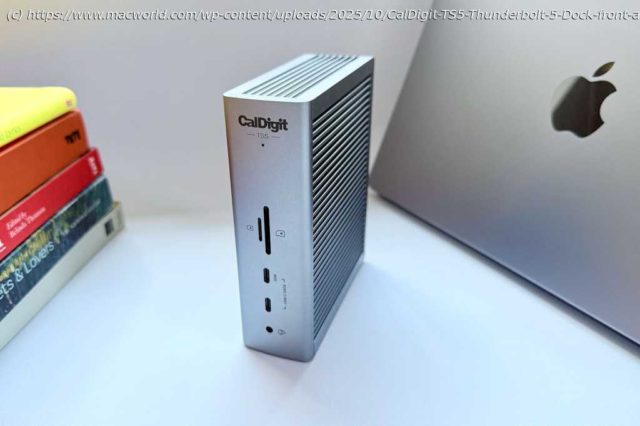This little sibling of the mighty TS5 Plus can stand up on its own. 15 high-end ports wow in this Thunderbolt 5 dock.
Price When Reviewed
€385,85
The CalDigit Thunderbolt Station 5 (TS5) is a bridge between the Olympian 20-port CalDigit TS5 Plus and the latest docking stations for mere mortals.
If you desire the ultimate in MacBook docking stations, the CalDigit TS5 Plus has just about everything you need—indeed probably more than you need. The plain TS5’s 15 ports should be enough for any but the more extreme pro-level users. The question is: are the TS5’s 15 ports the right mixture at the right price for you?Specs and features
One upstream Thunderbolt 5 port (80Gbps, 140W)
Three downstream Thunderbolt 5 ports (80Gbps, 36W)
One USB-C port (10Gbps, 20W)
Two USB-C ports (10Gbps, 7.5W)
One USB-A port (10Gbps, 7.5W)
One USB-A port (480MBps, 7.5W)
Ethernet (2.5Gb)
UHS-II SD card reader (312MBps)
UHS-II microSD card reader (312MBps)
3.5mm combo audio jack (front)
Two 3.5mm In/Out audio jacks (back)
240W power supply
All the ports are clearly labeled, which is appreciated.
That’s a great line-up of ports, even compared to its mighty 20-port TS5 Plus sibling. Indeed, the TS5 actually offers one more downstream Thunderbolt 5 port than the TS5 Plus, which sacrificed one of its TB5 ports for a DisplayPort.
The TS5’s lack of such a dedicated video port shouldn’t worry you. Any of the three downstream TB5 ports can be used to connect to a monitor. If the monitor supports a direct USB-C connection, then no adapter is required. If not, you’ll need a USB-C to DisplayPort or USB-C to HDMI adapter for the display connection.
Thunderbolt 5 doubles Thunderbolt 4’s data speeds from 40Gbps to bi-directional 80Gbps and up to 120Gbps in boost mode for higher display unidirectional bandwidth, resulting in significantly faster data transfers between devices and your Mac.
If you need to connect high performance SSDs or RAID devices Thunderbolt 5 rewards you with a PCIe performance that is doubled to 64Gbps PCIe 4.0, and the dock supports transfer speeds up to 6,200MBps.
The three USB-C ports are welcome, and the one at the front is rated at 20W, allowing for fast iPhone or iPad charging. Being something of a show-off the TS5 Plus boasted a 36W front-mounted USB-C port for even faster charging but 20W (just) exceeds Apple’s minimum 18W for speedy iPhone charging. Now we have 25W wireless charging it’s probably time for wired ports to offer that bit more.
The bigger TS5 Plus is armed with five USB-A ports, which we find excessive given that it’s aimed at professionals who surely would have ditched that annoying legacy port by now, although we acknowledge that some device makers persist with the non-reversible USB-A standard and it’s more common for portable memory sticks.
The TS5 dock trims the number of USB-A down to two, which we think is enough for any dock. One is rated at 10Gbps for data transfer and another for just 480MBps but both can output up to 7.5W to connected devices. The slower Type-A port can’t supply power when the dock is disconnected from the laptop, but the 10Gbps port and all the other power-giving ports do support offline charging.Compact power station
Thunderbolt 5 has a required higher power delivery (to a connected laptop) of at least 140W (up from TB4’s minimum 100W) with support for up to 240W (vs TB4’s max 140W). The TS5 can therefore power a connected laptop at up to 140W, enough to fast-charge a top-end 16-inch MacBook Pro. To achieve this, make sure you use the included 1m TB5 cable that can handle such power.
The TS5 Plus comes equipped with a super-generous 330W power supply, but the TS5’s 240W max should be enough for the ports that might require it: 1x 140W TB5, 3x 15W TB5, 1x 20W USB-C, and 5x 7.5W USB. That adds up to 242.5W and the dock will require some juice itself, but it’s plenty of power on hand. Most other docks max out at 180W and therefore add the risk that the all-important wattage going into the laptop might occasionally fluctuate to accommodate other hungry devices when over-loaded.
Домой
United States
USA — software CalDigit TS5 Thunderbolt 5 Dock review: Top-end dock with just the right...






